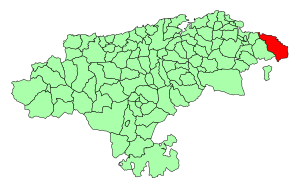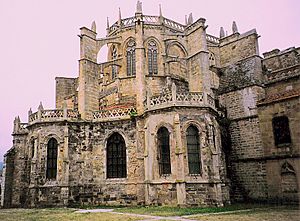Castro Urdiales facts for kids
Quick facts for kids
Castro Urdiales
|
|||
|---|---|---|---|

Port of Castro Urdiales, with the Church of Santa María de la Asunción in the background
|
|||
|
|||

Location of Castro Urdiales municipality in Cantabria
|
|||
| Country | |||
| Autonomous community | |||
| Province | Cantabria | ||
| Comarca | Eastern coast of Cantabria | ||
| Founded | Flaviobriga 74 AD | ||
| Area | |||
| • Total | 96.72 km2 (37.34 sq mi) | ||
| Elevation | 19 m (62 ft) | ||
| Population
(2018)
|
|||
| • Total | 31,977 | ||
| • Density | 330.614/km2 (856.29/sq mi) | ||
| Demonym(s) | Castreños | ||
| Time zone | UTC+1 (CET) | ||
| • Summer (DST) | UTC+2 (CEST) | ||
| Postal code |
39700
|
||
Castro Urdiales is a cool seaport town in northern Spain. It's located in the autonomous community of Cantabria, right on the Bay of Biscay. Castro Urdiales is a modern town, but it also has old buildings. Its castle and the big Church of Santa María de la Asunción are from the Middle Ages.
The main jobs here are tourism (people visiting), fishing, and packing fish. They especially pack sardines and anchovies. Factories like Lolin and La Castreña show how important fish canning is here.
About 32,000 people live in Castro Urdiales normally. But in summer, the number of people can get much bigger. It can even double or triple! People love its beaches and pretty harbor.
Contents
History of Castro Urdiales
Castro Urdiales was first called Portus Amanum by an old tribe. This was the main city for the Autrigones tribe.
Around 74 AD, the Romans built a city here. They called it Flaviobriga. This happened when Emperor Vespasian was in charge. They probably built it to mine the iron found in the area.
In 1163, Castro Urdiales got its own special rules as a town. This is called a municipal charter. It was part of the Kingdom of Navarre until 1200. Then, Alfonso VIII of Castile took over the area.
Castro Urdiales was in a great spot for trade. Goods moved between northern Europe and Castile through here. The town grew because of this. It stayed linked to Biscay until at least 1476.
In 1813, the town was destroyed by the French during the Peninsular War. But it was quickly rebuilt and made stronger. After 1879, more iron mining and railways came to the area. This helped Castro Urdiales grow fast in people and money.
Amazing Places to See
The old part of Castro Urdiales is called Puebla Vieja. It has buildings from the Middle Ages and is right by the sea. This area was made a special historical site in 1978.
Church of Santa María de la Asunción
This church is built in the Gothic style. King Alfonso VIII of Castile helped start its building in the 13th century. It was finished in the 15th century. Inside, you can see statues like the White Virgin and the Reclining Christ. There are also three Gothic carvings of the Magi. It was named a National Monument in 1931.
Santa Ana Castle and Lighthouse
The Castle of Santa Ana is close to the port and the Santa María de la Asunción church. Today, it has a lighthouse inside.
Other Interesting Sights
- Ocharan Palace and Gardens: This palace and its gardens are protected since 1985. The castle-observatory was built in 1914. It looks like an old Gothic castle. The Ocharan Palace, also called Toki-Eder, was built in 1901. It has a mix of styles, with columns and colorful tiles.
- El Cuco Cave: This cave is west of the town. It has ancient rock carvings and paintings from the Upper Paleolithic period. You can see pictures of animals like deer, goats, and horses.
- Roman Remains of Flavióbriga: Under the old town, you can find parts of the Roman city of Flavióbriga. These remains are about two meters deep. Some Roman items can be seen at the Regional Museum of Prehistory and Archaeology of Cantabria.
- Roman Mile-stone: Opposite the Church of Santa María, there's a Roman mile-stone from 61 AD. It shows the distance to a place called Pisoraca. The stone has an inscription about Emperor Nero.
Twin Towns
Castro Urdiales is twinned with these towns:
 Aire-sur-l'Adour, France
Aire-sur-l'Adour, France Bucraa, Western Sahara
Bucraa, Western Sahara Miyek, Western Sahara
Miyek, Western Sahara Jerez de la Frontera, Spain
Jerez de la Frontera, Spain
Images for kids
See also
 In Spanish: Castro-Urdiales para niños
In Spanish: Castro-Urdiales para niños









